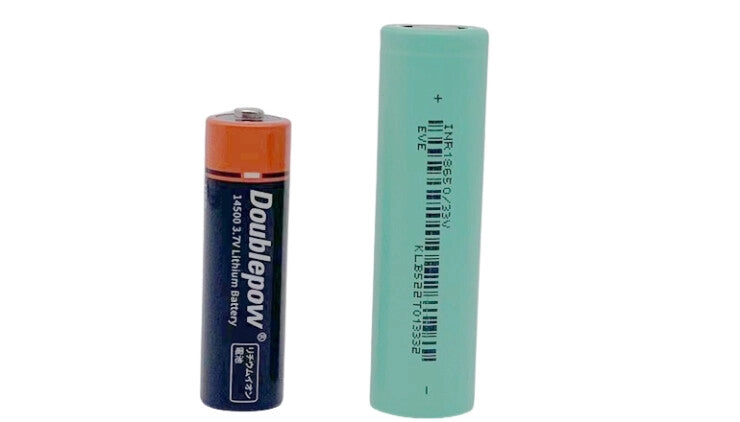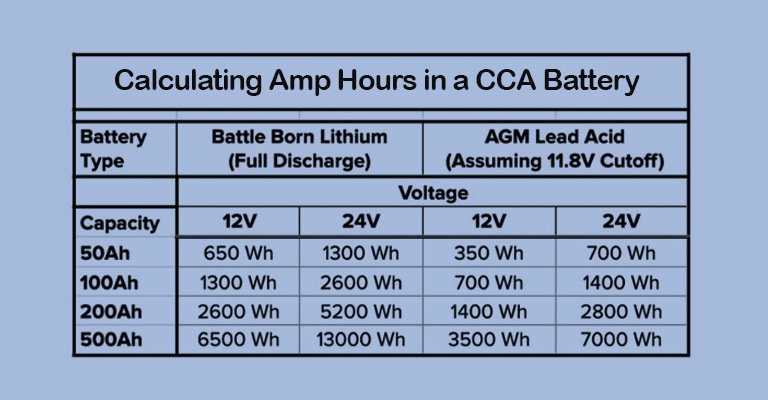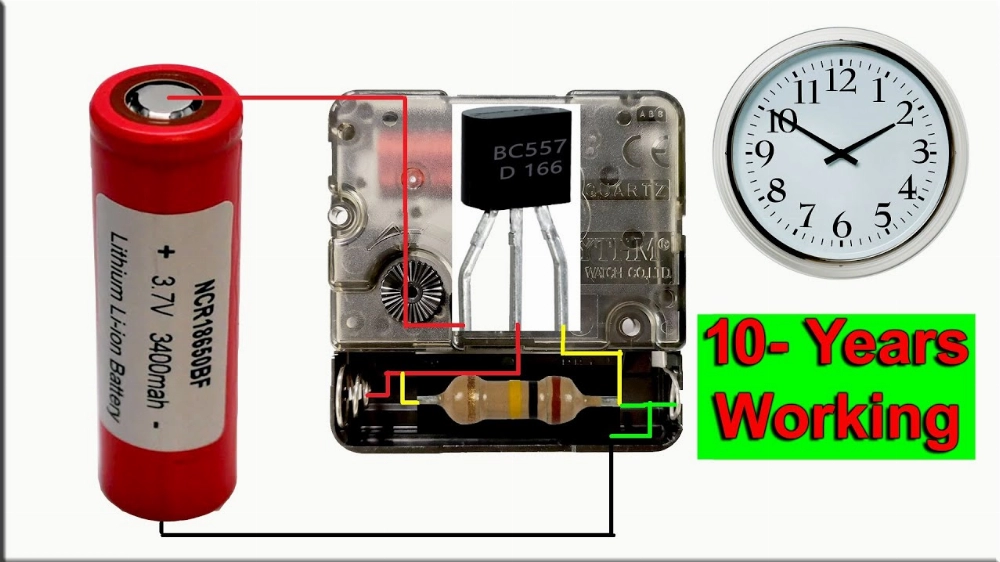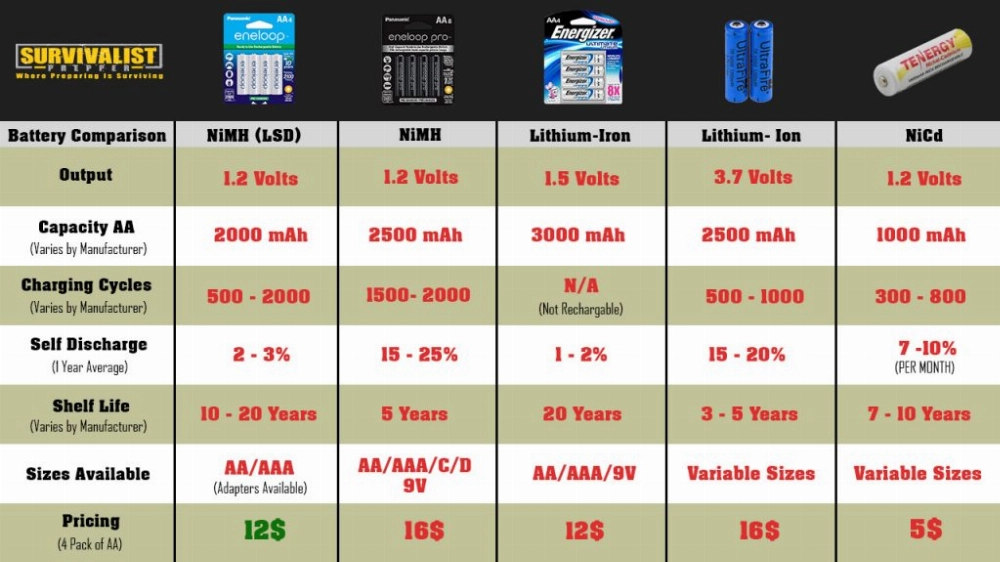18650 Battery vs. AA Battery: A Comparison
Batteries, such as the 18650 and AA types, are essential power sources in our daily lives, powering a wide variety of devices. In this comparison, we will explore the differences between these two popular battery types. Both batteries play crucial roles in various industries and everyday applications.
Part 1. What is an 18650 Battery?
An 18650 battery is a cylindrical lithium-ion rechargeable battery that measures 18 mm in diameter and 65 mm in length. Known for its high energy density and rechargeability, it is commonly used in various electronic devices because of its ability to provide long-lasting power. This battery is known for its reliability and efficiency, delivering consistent performance in a multitude of applications, making them widely popular.
Advantages of 18650 Batteries
- Superior Energy Density: 18650 batteries are known for their exceptional energy density, enabling them to provide longer run times without frequent recharges.
- Rechargeability: As rechargeable batteries, 18650 batteries offer cost-effectiveness and reduced environmental impact compared to disposable alternatives.
- Versatility: These batteries are well-suited for high-drain devices like laptops, flashlights, and electric vehicles because they can meet high power demands.
- Long Lifespan: If properly maintained, 18650 batteries have a longer lifespan than many other types of batteries, ensuring reliable performance over time.
Shortages of 18650 Batteries
- Market Demand: The 18650 battery market occasionally faces shortages due to surging demand from various sectors, including electronics, energy storage, and vaping products (e-cigarettes).
- Production Challenges: Manufacturers often struggle to keep up with the growing demand, leading to intermittent supply shortages that impact market availability and pricing.
- Global Trends: Raw material and production fluctuations further contribute to periodic shortages in the 18650 battery market.
Supply Chain Challenges and Market Trends
- Supply Chain Issues: With the surge in demand from sectors like electric vehicles and renewable energy storage, the demand for 18650 batteries has increased dramatically, leading to supply shortages that impact pricing and market availability.
- Future Trends: As electric vehicle production expands, the demand for 18650 batteries is expected to continue growing. Additionally, advancements in energy storage technologies will further drive the need for these high-performance lithium-ion batteries.
Applications of 18650 Batteries in High-Performance Devices
18650 batteries are well-suited for powering high-drain devices that require sustained energy output. Their superior energy density makes them a preferred choice for powering devices that need consistent high power.
- Electronics: 18650 batteries are ideal for laptops, power tools, and portable chargers because of their high energy density and long-lasting power.
- Electric Vehicles: These batteries are widely used in electric vehicles, providing the necessary power for efficient vehicle operation.
- Outdoor Activities: For outdoor equipment like high-performance flashlights and camping gear, 18650 batteries are an optimal choice because of their robust energy output.
Part 2. What is an AA Battery?
AA batteries are small, cylindrical batteries commonly used in everyday devices like toys, remote controls, and portable gadgets. Measuring approximately 1.5 cm in diameter and 5 cm in length, AA batteries are available in both disposable and rechargeable options. Their affordability and compatibility with many devices make them a popular choice for powering a variety of household items.
Advantages of AA Batteries
While AA batteries do not have the same energy density as 18650 batteries, they still provide sufficient power for low-drain devices. Their energy density makes AA batteries an economical and readily available power source for everyday electronics.
- Versatility: AA batteries are compatible with a wide range of devices, from household items like remote controls and toys to small gadgets that require stable, low-power operation.
If you’re looking to learn more about energy storage and various types of lithium batteries, check out our Lithium Iron Phosphate Battery guide.
In summary, 18650 batteries offer high energy density and are suitable for high-power applications like electric vehicles and laptops, while AA batteries are more versatile and economical for low-power devices like toys and remote controls. Both battery types play essential roles in powering our modern lives, each with its own strengths and optimal use cases.
AA Batteries: The Common Power Solution for Everyday Devices
AA batteries are one of the most widely used power sources in homes, commonly found in various devices such as remote controls, clocks, small electronics, and toys. They are popular due to their widespread availability, affordability, and convenience.
Advantages of AA Batteries
Availability
AA batteries are available in most stores, making it easy to replace them when needed. This ensures that devices requiring them are always powered, guaranteeing their normal operation.
Affordability
Compared to larger rechargeable batteries, AA batteries are relatively inexpensive. This makes them an affordable solution for everyday devices that require frequent battery changes.
Convenience
The compact size and standardized shape of AA batteries ensure easy interchangeability between various devices, providing a convenient and reliable power solution for numerous applications.
Limitations of AA Batteries
Limited Capacity
Compared to larger rechargeable batteries, AA batteries typically have lower energy density. This results in shorter usage times, especially in high-drain devices, making them less suitable for high-power applications.
Environmental Impact of Disposal
Most AA batteries are disposable, which leads to environmental concerns. The accumulation of used batteries presents recycling and disposal challenges.
Limitations of Rechargeable AA Batteries
Rechargeable AA batteries are available, but they tend to have lower capacities compared to other rechargeable battery sizes, potentially requiring frequent recharging. This can reduce their long-term cost-effectiveness in high-power devices.
Performance in High-Power Devices
In devices with high power demands, AA batteries may not provide consistent performance, leading to quicker depletion and the need for more frequent replacements.
AA Battery Shortages and Future Trends
Environmental Impact
The disposable nature of AA batteries leads to significant environmental concerns. As a result, there’s a growing shift towards more sustainable battery technologies, including the increased adoption of rechargeable AA batteries.
Market Demand
While the demand for AA batteries remains steady, the rise of portable electronics and smart devices may lead to a growing demand for more efficient and rechargeable AA options. This evolution addresses the increasing need for better performance and sustainability.
Common Applications of AA Batteries
Household Appliances
Various everyday household appliances such as remote controls, clocks, wireless keyboards, and computer mice are powered by AA batteries. These devices benefit from the affordability and availability of AA batteries.
Toys and Gadgets
AA batteries are commonly used in small electronics, such as handheld gaming devices and toys. Their compact size makes them an ideal power solution for these portable products.
Healthcare Devices
Many health-related devices, such as blood pressure monitors and thermometers, rely on AA batteries. They provide a reliable power source for essential daily health tools.
18650 vs. AA Batteries: Choosing the Right Battery for Your Needs?
In this section, we will compare 18650 and AA batteries, focusing on key factors such as size, energy density, performance, and specific use cases. Understanding the differences between these two battery types will help you decide which one best suits your requirements.
Size
18650 Batteries
18650 batteries are larger, measuring approximately 18 mm in diameter and 65 mm in length. This size makes them more suitable for devices that require a significant amount of power. However, it also means they take up more space in devices.
AA Batteries
AA batteries are smaller, typically ranging from 14.5 mm to 14.9 mm in diameter and 50.5 mm to 50.7 mm in height. Their compactness makes them easy to use in smaller devices where space is limited.
Capacity and Energy Density
18650 Batteries
18650 batteries are known for their high energy density and larger capacity. This enables them to power devices that require sustained, high-drain performance, such as laptops and electric vehicles.
AA Batteries
While AA batteries are versatile, they generally have lower energy density and capacity compared to 18650 batteries. They are better suited for smaller, low-power devices.
Voltage and Performance
18650 Batteries
18650 batteries typically offer a higher voltage (around 3.7V), which is necessary for high-power applications. This makes them ideal for devices that require a significant power output, such as power tools or electric vehicles.
AA Batteries
AA batteries usually provide a lower voltage (around 1.5V), making them more suitable for devices with lower power requirements, such as remote controls or clocks.
Applications and Uses
18650 Batteries
18650 batteries are commonly used in devices that require a substantial amount of power, including laptops, power tools, flashlights, and electric vehicles. Their higher capacity allows them to power these high-drain devices.
AA Batteries
AA batteries are commonly found in low-power devices like remote controls, toys, and medical equipment. Their lower energy capacity makes them unsuitable for high-drain applications but perfect for everyday, low-power gadgets.
Considering these comparisons, you can make an informed decision about which battery type is best suited for your needs. Whether you are looking for the compact convenience of AA batteries or the high-power capabilities of 18650 batteries, both offer unique advantages for different applications.
18650 Battery versus AA Battery: A Comprehensive Comparison
Power Consumption and Applications
18650 Batteries:
These batteries are designed for high-power applications, commonly found in devices like power tools, laptops, and electric vehicles. Their high energy capacity makes 18650 batteries ideal for power-hungry devices requiring sustained high energy output.
AA Batteries:
AA batteries are commonly found in everyday household items like remote controls, toys, clocks, and other small electronic devices. Their smaller size makes them suitable for low-power devices that require less energy.
Rechargeability
18650 Batteries:
These batteries are primarily rechargeable, making them a more sustainable and cost-effective option compared to non-rechargeable batteries. Their higher capacity and longer lifespan make them particularly suitable for devices that may require frequent charging.
AA Batteries:
AA batteries are available in both disposable and rechargeable forms, giving users more options. However, rechargeable AA batteries typically have a lower capacity than 18650 batteries, especially for power-hungry devices. AA batteries are better suited for everyday devices, while 18650 batteries excel in high-demand applications.
Size, Capacity, and Voltage: Choosing the Right Battery
When choosing the right battery for your device, size, capacity, and voltage are key factors to consider. Here’s a comparison:
18650 Batteries:
18650 batteries measure 18mm in diameter and 65mm in length, offering superior capacity, typically up to 3500mAh, and a higher voltage of 3.7V. These characteristics make them well-suited for high-drain (high-power) devices like power tools, laptops, and electric vehicles.
AA Batteries:
AA batteries are smaller, measuring 14.5mm in diameter and 50.5mm in length. They typically have a lower capacity, around 2500mAh, and a voltage of 1.5V. AA batteries are better suited for low-power devices like remote controls, toys, and small household devices.
For high-power devices like gaming laptops or power tools, 18650 batteries offer a more reliable power source. Conversely, AA batteries are better suited for everyday gadgets that don’t require as much power.
Frequently Asked Questions (FAQ)
Can you use AA batteries instead of 18650 batteries?
Due to differences in size, voltage, and capacity, AA batteries cannot directly replace 18650 batteries. Modifying a device to use AA batteries instead of 18650 batteries may be impractical or not recommended.
Is there an equivalent alternative to an 18650 battery?
While the voltage of an 18650 battery can be achieved by connecting multiple AA or AAA batteries, it offers higher capacity and energy density in a single cell. However, it is not interchangeable with AA or AAA batteries due to differences in size and voltage.
What is special about an 18650 battery?
18650 batteries are known for their high energy density, rechargeability, and ability to provide sustained power. These qualities make them an excellent choice for devices like laptops, flashlights, power tools, and electric vehicles.
What devices can an 18650 battery power?
18650 batteries can power a variety of devices, including flashlights, e-cigarettes, cordless power tools, laptops, cameras, and electric vehicles that use large battery packs.
Is an 18650 battery the same as three AAA batteries?
No, an 18650 battery is not equivalent to three AAA batteries. The 18650 is a single-cell lithium-ion rechargeable battery with a higher voltage and capacity than three AAA batteries in series.
Related Tags:
- KHZH (Keyword Combination for Search Engine Optimization – SEO)
- Lithium Battery Content Writer
Portable Battery Charger vs. Power Bank: What’s the Difference?
A portable battery charger is a general term for any mobile charging device. A power bank, however, is specifically designed to store energy in *its* battery, allowing you to charge your devices without an active power source.
A Complete Guide to Lithium-Ion Jump Starters
Lithium-ion jump starters are invaluable in emergencies, especially for car battery issues. This comprehensive guide will guide you through their proper usage, maintenance, safety tips, and why they are a wise investment for all car owners.
What is a Portable Battery Charger?
Portable battery chargers are designed to keep your devices charged on the go. This guide explains what it is, the materials used in its construction, and how it works, for easy understanding. For more information on safely charging lithium-ion batteries, see our Guide to Safely Charging Lithium Batteries with a Normal Charger.
How to Choose the Best Battery Pack for Your Needs: Capacity, Performance, and More
Choosing the right battery pack is crucial to ensure reliability and optimal performance. This guide covers capacity, safety, and other key aspects to help you make informed decisions.








